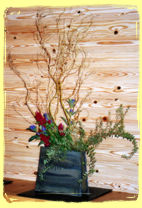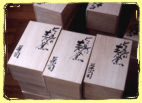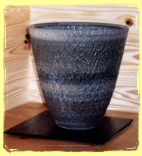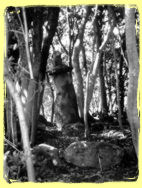



Slab Built Vase


Large Bowl


Cups and Saucers
In 1993, I had the fortune to meet Eiji Kinoshita at a museum in Connecticut where he was exhibiting his works and demonstrating his throwing skills. While conducting my Fulbright research in Japan, I had the opportunity to get to know Eiji better; I would like to share somethings about him with the readers of Critical Ceramics.
Today, Eiji Kinoshita is a potter who lives and works in Oita Prefecture, in Kyushu Japan. As a child, Eiji was a serious painter; upon graduating from high school, he became an apprentice to the potter Hidetaka Ota in Koishiwara. Koishiwara is a region in Kyushu known for its mingei style folk pottery derived from Korea. Eiji apprenticed at Koishiwara for seven years before becoming an independent potter at the age of 25. Since then he has supported himself solely by exhibiting and selling his pots. He throws, forms shapes with slabs, and hand builds his works all of which are all functional.
Although Eiji apprenticed under strict rules guided by strong traditional values where potteries are passed down from father to son, he does not come from a family of potters. In Japan’s ceramic world where lineage can be empowering, a first generation potter can face rejection and hardships. On the other hand, not having the burden of the familial history enables one to establish a studio and a distinct style with much creative liberty. Balancing the old with the new, he has processed all that he learned, adjusting it to suit his own vision.
For example, in his studio lies a huge pug mill. I had heard that apprentices spend their beginning years just wedging and wedging, ultimately producing purist potters who need to wedge every piece of clay they handle. This is definitely not the case with Eiji; he hardly ever wedges. Curtly, he explains, “time is money, I can make 50 pots during the time I spend spiral wedging. Pug mills are much more efficient, economical, and I’m saving my wrists so I can throw for more years.” Indeed, his pug mill provides lump after lump of bubbleless clay. In the span of the hour that it might take him to wedge 60 pieces of clay, he can throw dozens of cups, bowls, or saucers. There is little effort wasted. Eiji’s precise thowing is awe-inspiring proof of his dedication to his craft, and the ancient education of apprenticeship which led him to where he is today.
In general, Koishiwara ware is known for its chattering marks and slip decoration. Often, pieces have slip with chatter marks, a reverse of the Korean pots that have chatter marks with inlaid slip designs. On his recent large bowls, Eiji has been using this chattering technique to an extent where he creates a whole surface covered with this texture rather than using it just as a decorative motif.
The resulting texture in Eiji's pieces almost look manic, as though a happy beaver got to one of his pots. While working at his studio, Eiji taught me how to chatter. To my surprise, the chattering tool looked nothing like what I had envisioned. Instead of the metal trimming tool that I thought was used, the chattering marks are made by letting a curved piece of flat steel (about an inch in width) rhythmically bounce off leather hard ware. The tool is actually made from a piece of a coiled stainless steel spring from an old grandfather clock. With the digital age in full force, it’s becoming harder to find these steel clock springs.
Another technical trick of the trade of his that can shatter purist intimidations — throwing with gloves on. Eiji wears gunte gloves to throw large pieces. Gunte, are the most common of common knit cotton work gloves sold in bundles at any Japanese hardware store. They are basically like sweat socks for hands and similar gloves can be found at hardware stores in the states (although the knit seems a bit looser). Eiji accidentally chanced upon this technique one day while he was firing. He had his gloves on to adjust his kiln, later forgot to take them off, and started throwing. Apparently, the wet gloves act as a sponge and the drag of the cotton makes it easier to work on large pieces.
Eiji’s firing technique while embracing some traditions, defies others. For example, he fires his gas kiln at a frighteningly fast pace allowing the temperature to climb hundreds of degrees in a few hours. At the end of the firing, once the kiln reaches temperature, he throws a log into his kiln, and then turns the burners off! This lets the log burn and smoke the kiln, ultimately soaking it in a reduced state. His kiln has a small chamber at the bottom specially made for receiving the log. It is like firing a gas kiln and adding a touch of a wood firing. After a few firings, ash collects in this chamber and these ashes are used to make glazes. This firing technique produces a dark rich metallic sheen.
1998 marked Eiji’s tenth year since becoming an independent potter. He keeps a strenuous schedule, exhibiting on a near monthly basis from September until June and takes the summers off to travel. In 1998, Eiji was also in the midst of constructing a new studio and gallery atop an unsettled mountain. The scenery and landscape, overlooking mountains on one side and the ocean on the other, inspire one to strive for beauty. To inhabit such an undeveloped area, telephone poles were dragged and planted, water pumped from newly connected pipes, the cable man had to construct a satellite dish, and long electrical wires were brought into the site.
This mountain certainly hadn’t been inhabited in the recent past. However, when the area was initially cleared to begin construction, a very auspicious landmark was discovered. Amidst the trees, a cluster of stone arrangements, known as a stone circle was found. It consists of a tall stone with a flat rock and another smaller rock balanced on it, surrounded by two outer rings of rocks. Two other stone circles exist in neighboring towns and when plotted on a map, these stone circles align to form a straight line. Eiji took this back yard stone circle as a sign that the land was once inhabited by ancient people, and thus favorably spirited. Since moving to this new studio site, a cup of water or sake (rice wine) has always been offered to the stone circle and surely the mountain gods keep Eiji company as he continues to enhance his traditionally trained skills with his progressive visions.


Wedding Cups and Boxes


Large Vase


The Stone Circle